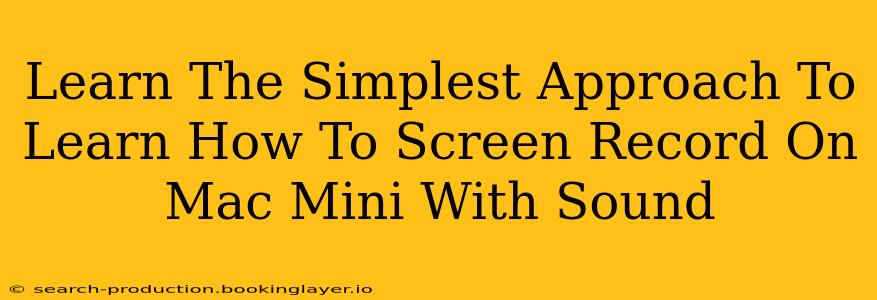Screen recording on your Mac Mini with sound might seem daunting, but it's surprisingly simple! This guide breaks down the easiest methods, perfect for beginners. Whether you're creating tutorials, capturing gameplay, or recording online meetings, we've got you covered. Let's dive in!
Quickest Method: Using QuickTime Player
QuickTime Player, pre-installed on your Mac, is your secret weapon for quick and easy screen recordings. Here's how to record your screen with audio:
- Open QuickTime Player: Find it in your Applications folder.
- Start a New Screen Recording: Go to "File" > "New Screen Recording."
- Choose Your Recording Options: A small window will appear. Click the dropdown arrow next to the record button to select your microphone (built-in or external) for audio capture. You can also choose to record the entire screen or a specific portion.
- Record! Click the record button to begin. A red bar at the top of your screen will indicate that the recording is in progress.
- Stop Recording: Click the stop button in the menu bar or press Command-Control-Escape.
- Save Your Recording: QuickTime will automatically open your recording. Choose "File" > "Save As" to save it in your desired location and format (typically .mov).
Pro Tip: For capturing only a specific application window, click the dropdown arrow next to the record button and choose the application window from the list.
For More Advanced Features: OBS Studio
OBS Studio is a free and open-source software offering significantly more advanced features than QuickTime Player. While it has a steeper learning curve, it’s perfect for more complex screen recordings.
- Multiple Scenes: Organize your recording into distinct scenes, like switching between game footage and webcam feed.
- Customizable Audio Sources: Mix and adjust audio levels from multiple sources (microphone, game audio, etc.).
- Streaming Capabilities: Easily stream your recordings live to platforms like Twitch or YouTube.
Getting Started with OBS Studio:
- Download and Install: Download OBS Studio from the official website.
- Configure Sources: Add sources like "Display Capture" (for screen recording) and "Audio Input Capture" (for microphone input). OBS has an intuitive drag-and-drop interface for arranging your sources.
- Set Audio Levels: Adjust the audio levels to prevent clipping or unwanted background noise.
- Start Recording: Click the "Start Recording" button.
- Stop and Save: Click the "Stop Recording" button to save your recording. OBS will allow you to choose your preferred file location and format.
Troubleshooting Common Issues
- No Sound: Ensure your microphone is selected as an audio source in your recording software's settings. Check your Mac's system sound settings to make sure the microphone is working correctly.
- Low Audio Quality: Experiment with different microphones and adjust audio levels to optimize sound quality.
- Laggy Recordings: Close unnecessary applications to free up system resources and improve performance.
Choosing the Right Method
For simple, quick screen recordings with sound, QuickTime Player is the clear winner. It's easy to use and requires no extra downloads. If you need more advanced features like scene switching, custom audio mixing, and streaming capabilities, OBS Studio is the superior choice, but requires a little more setup.
This guide provides a simple, easy-to-understand approach to screen recording on your Mac Mini with sound. Remember to practice and experiment to find the method that best suits your needs and recording style!

